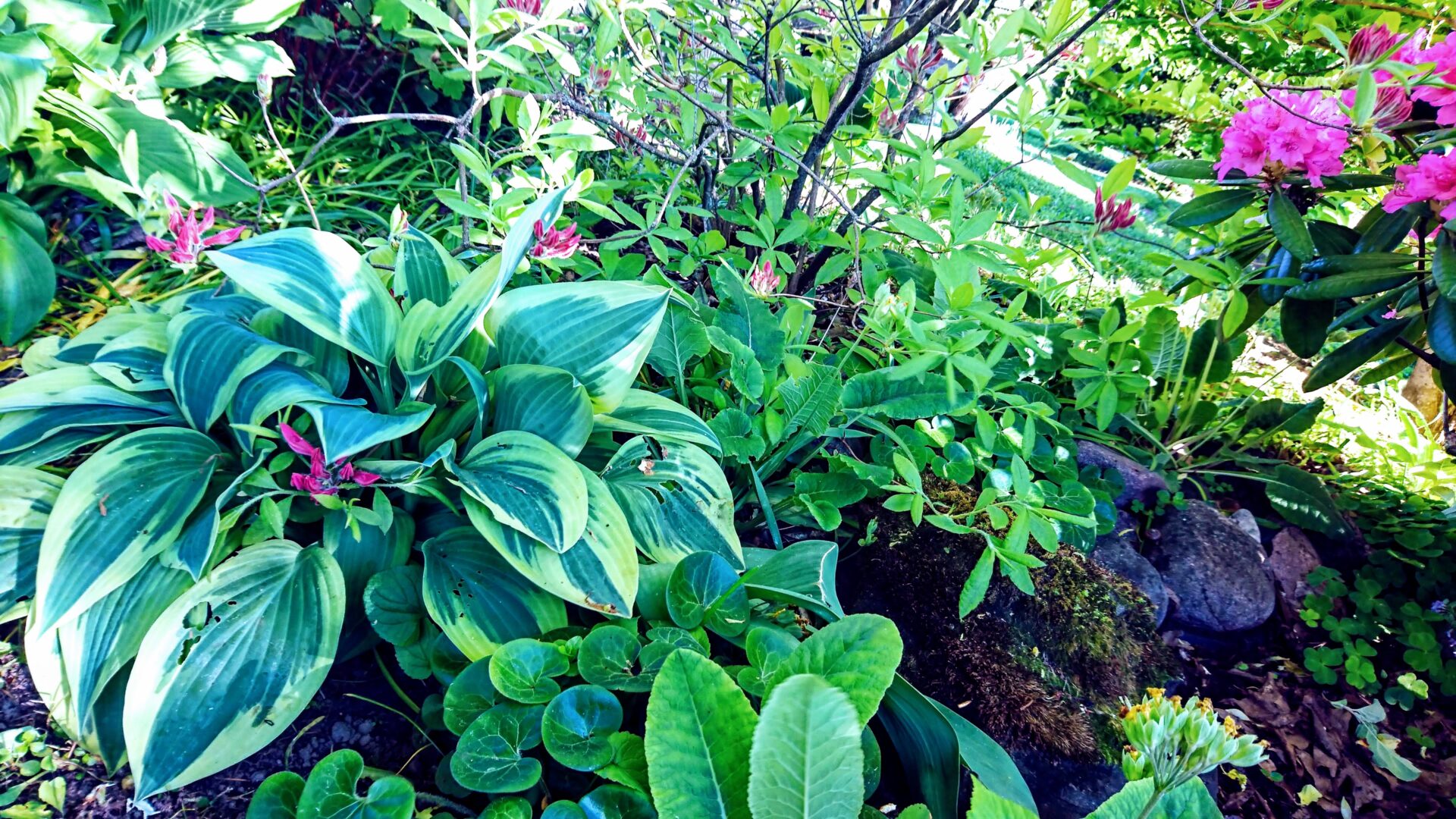Hostad on koos okkalistega samuti mu suured lemmikud. Eriti sellepärast, et nad on suht hooldusvabad tegelased. Kaevad korraliku augu maasse, lisad sinna hoo andmiseks head-paremat, istutad maha, vajadusel esimesel aastal kastad ja siis jääd huviga ootama, millal tulemused saabuvad. Isiklik kogemus näitab, et rohevahetuse käigus puhma jagamise teel saadud taimede puhul saabub tulemus reeglina kiiremini, kui puukoolist ostetud tittede (seemikute) puhul. Viimastega tuleb paar head aastat oodata enne kui nad õige hoo sisse saavad. Kuna meie aed on enamuses lõunapäikesele avatud, siis varasematel aastatel olin hädas oma lemmikutele sobiva koha leidmisega. Nüüdseks aga on õnneks juba turule tulnud ka päikest taluvad sordid. Rohevahetuse käigus saadud taimede puhul aga ei tea kahjuks tihti nende õiget nime, sest sarnaseid sorte on palju. Meie aias kasvas enne meid ühe õunapuu varjus suur-suur laik tavalist roheliste lehtedega hostat, kust siis jagasin materjali nii enda peenardele kui ka sõpradele. Naabrilt sain lisaks heleroheliste tumerohelise äärisega lehtedega hosta ja nii ma nad alguses rõõmsalt tiigi äärde kõrvuti istutasingi.
Hostas are also big favorites of mine, along with conifers. Especially because they are relatively low-maintenance characters. You dig a proper hole in the ground, add good things to give it a boost, plant it, water it if necessary in the first year, and then wait with interest to see the results. Personal experience shows that in the case of plants obtained by dividing an old plant during the green change, the result usually comes faster than in the case of babys (seedlings) purchased from a nursery. With the latter, you have to wait a few good years before they get the right momentum. Since our garden is mostly open to the southern sun, in previous years I had trouble finding a suitable place for my favourites. Fortunately, by now, sun-tolerant varieties have already entered the market. Unfortunately, in the case of plants obtained during green change, their correct name is often not known, because there are many similar varieties. In our garden, before us, in the shade of an apple tree, a large, large patch of ordinary hosta with green leaves grew, from which I distributed the material both to my beds and to my friends. I also got a hosta with light green leaves with a dark green border from a neighbor, and so I happily planted them side by side by the pond at first.
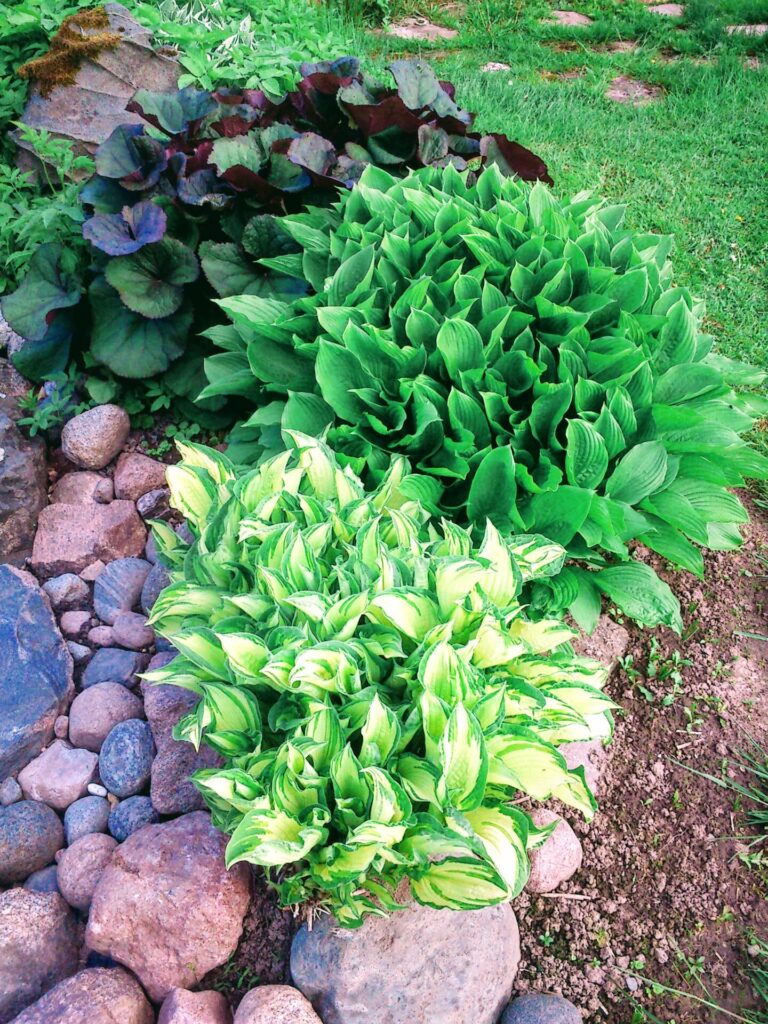
Hostad laienesid seal jõudsalt ja hakkasid juba otsapidi veetaimedeks pürgima. Trügisid oma teelt eest väiksemaid kive ja mis eest keeldus liikumast, sellele roniti lihtsalt otsa. Samuti kaotas heleroheline hosta kesksuveks päikese käes oma ilusa värvi ning triibud ja muutus kuidagi luitunuks. Jagasin neid küll jupikaupa sõpradele laiali, aga mis liig see liig. Kõigele lisaks tegi viimaste põuaste suvede kõrvetav päike neile seal ilmselgelt liiga. Selle kohta pildimaterjali leiab postitusest Tiigilugu. Oli saabunud aeg muutusteks.
The hostas expanded there vigorously and began to aspire to become aquatic plants. They pushed smaller stones out of their way and anything that refused to move was simply climbed on top of. Also, by mid-summer in the sun, the light green hosta lost its beautiful color and stripes and became somehow to faded down. I distributed them piece by piece to my friends, but what too much is too much. In addition to everything, the scorching sun of the last drought summers was obviously did damage for them there. Pictures about this can be found in the post Tiigilugu. It was time for a change.
Esimesena kolis kadaka varju elama heleroheline hosta. Tõenäoliselt on tegu Fortune’i hostaga Albopicta, see seletaks ka suvise luitumise.
The first to move into the shade of the juniper was the light green hosta. It is probably Fortunei hosta Albopicta, which would also explain the summer fade.
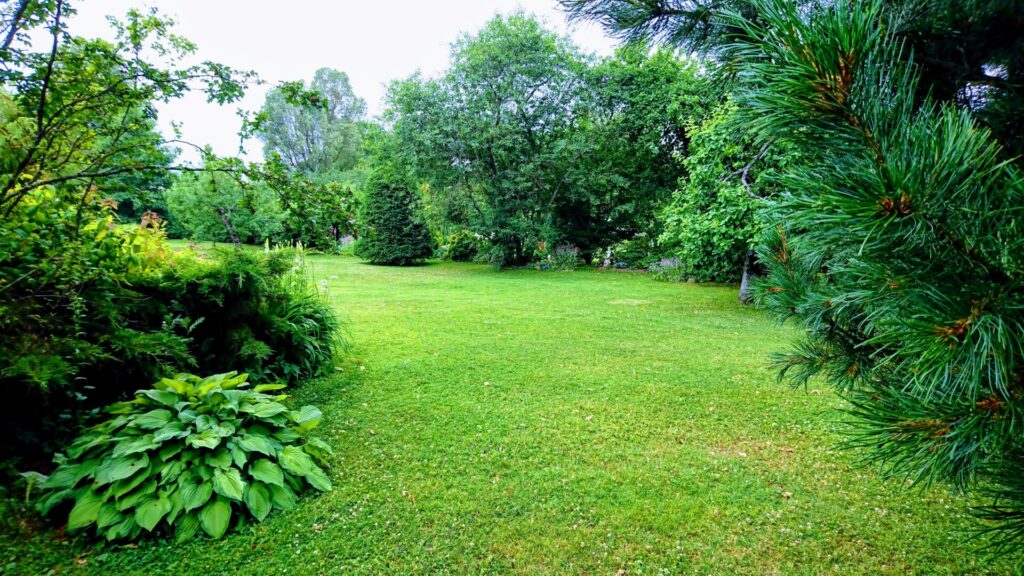
Järgmisena kolis tiigi äärest maja varju kähar hosta, keda asendama tuli Halcyon. Viimane on üks tubli tegelane, ei kiusa teda väga ei teod, ei päike.
Next a hosta crispula moved by the pond to the shade of the house, and was replaced by Halcyon. The latter is a good character, neither snails nor the sun bother him much.
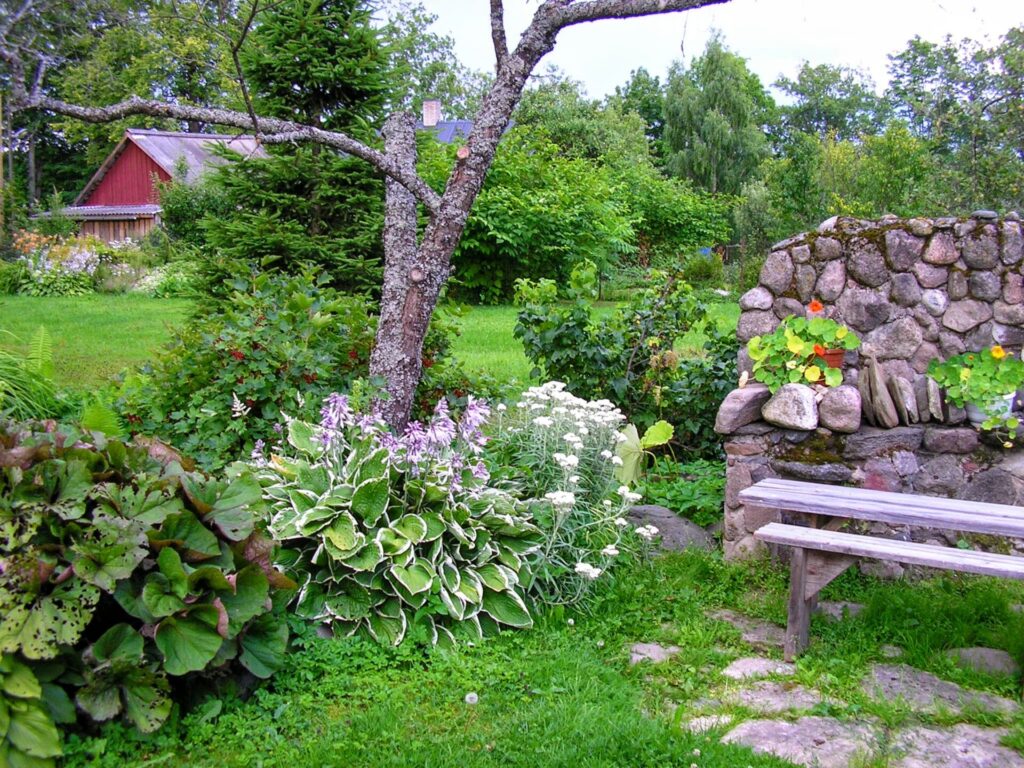
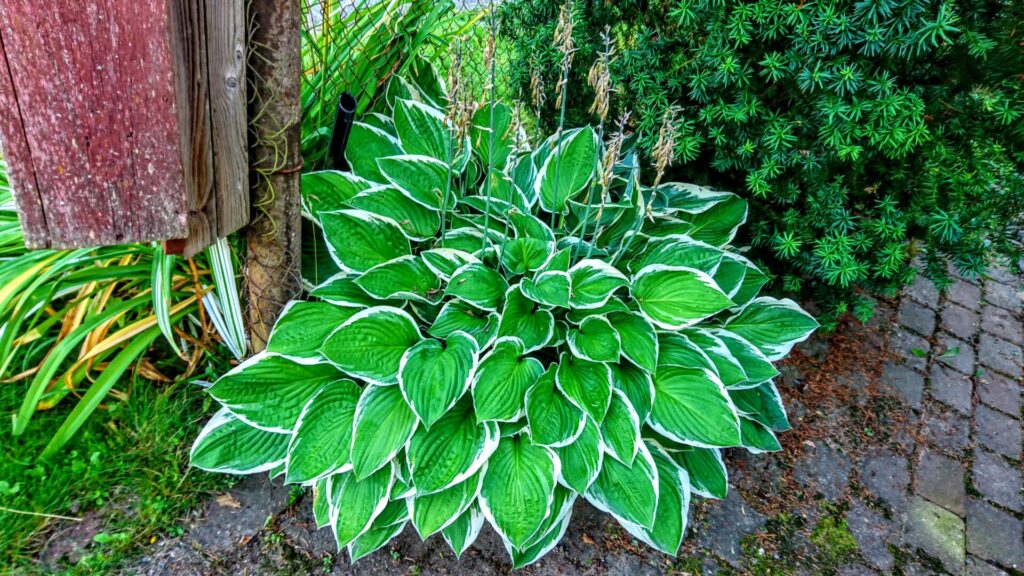
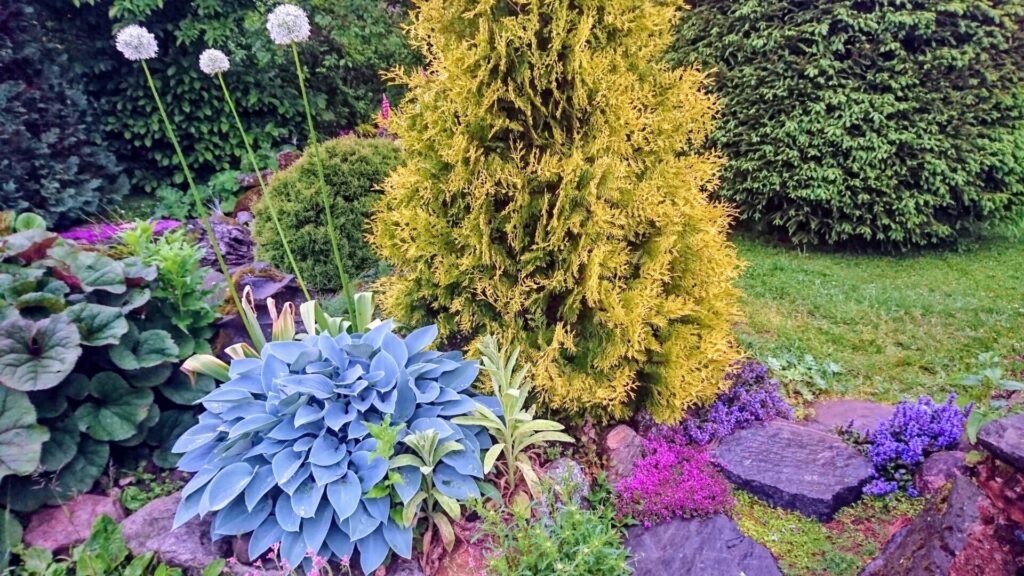
Albopictat asendama istutasin juba 2019. aastal hosta Thunderbolt, kes talub küll kenasti päikest, aga kes rammusat algsuutäiest ja iga-aastasest komposti lisamisest-väetamisest hoolimata ei taha kuidagi õiget hoogu sisse saada.
To replace Albopicta, I already planted hosta Thunderbolt in 2019, which tolerates the sun nicely, but which, despite the large initial mouthful and annual compost addition-fertilization, does not want to gain the right momentum.
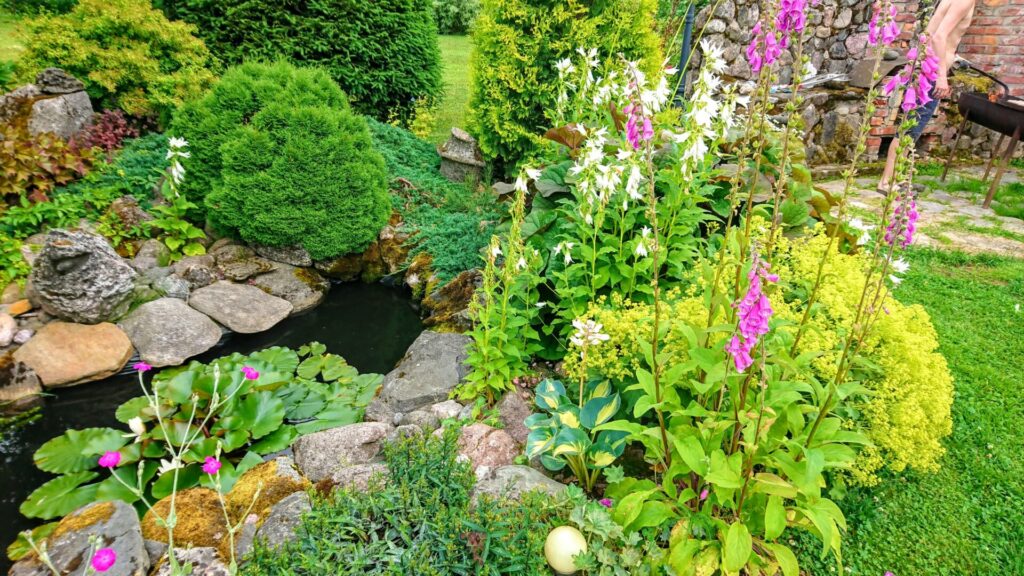
Aastaid tagasi, 2007, sain rohevahetuse käigus hosta Sum & Substance, kes tundub olevat nõus kasvama igasugustes oludes: päikese käes ja puude juurte peal. Veidi väetamist vahel ei tee muidugi ka paha sellistes oludes. Kirjade järgi peaks ta olema ebameeldiv tigudele, aga meie aia näljastest ahnepäitsudest on küll tema taga lausa järjekord nii kui aga võimalus avaneb. Laienemiskiirus on tal samuti korralik, jagatud on teda sõpradele ikka tublisti, peabki talle vahepeal lisa kasvatamiseks puhkust andma.
Many years ago, in 2007, during a green change, I got hosta Sum & Substance, which seems to be willing to grow in all conditions: in the sun and on the roots of trees. Of course, a little fertilizing sometimes does no harm either in such circumstances. According to the letters, this hosta should be unpleasant for snails, but of the hungry and greedy snails in our garden, there is quite a queue behind him whenever the opportunity arises. His expansion speed is also decent, he has been shared a lot with his friends, he needs to be given a break to grow more in the meantime.
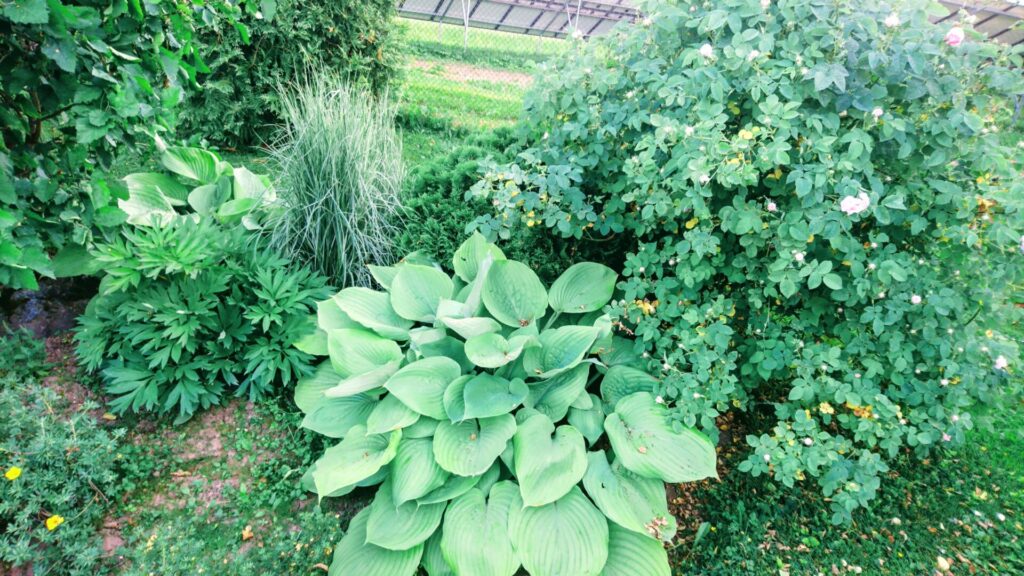
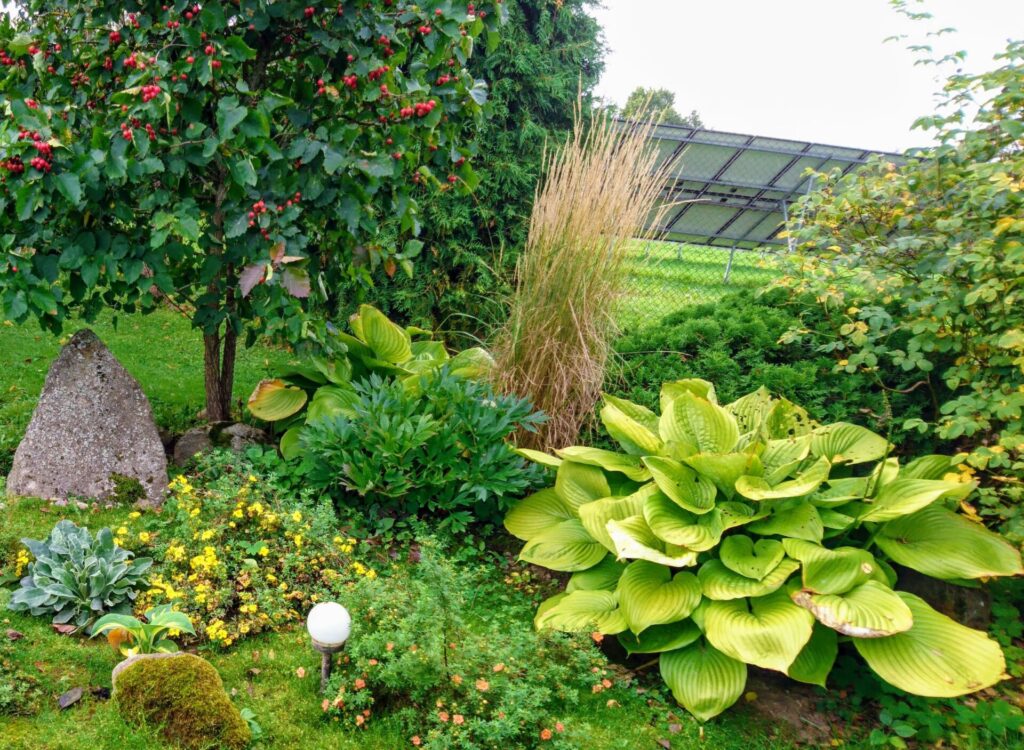
2017. aastal sai mul lõplikult kõrini vaarikate vahele elama asunud naatide vahtimisest. Kui neist ikka jagu ei saa, tuleb need kuidagi ära varjata. Istutasin sinna ette kaks tulevast hiiglast: hostad Empress Wu ja Regal Splendor. Kuna vaarikad paljunevad juurevõsudega, olin kunagi pannud nende ees olevale peenrale alla juuretõkkekanga. Peenar oli algselt mõeldud iiristele, millest tulenevalt polnud sealne mullakiht kuigi paks. Asendasin vana mulla uuega ja istutasin taimehakatised maha mõttega, et ilmselt tuleb millalgi see kõik uuesti üles kiskuda ja peenar sügavamaks teha.
In 2017, I finally got fed up with staring at the ground elder that settled among the raspberries. If you still can’t defeat them, you have to hide them somehow. I planted two future giants there: hostas Empress Wu and Regal Splendor. Since raspberries reproduce by root shoots, I had once put a root barrier fabric under the bed in front of them. The bed was originally intended for irises, as a result of which the soil layer there was not very thick. I replaced the old soil with new and planted the seedlings with the idea that at some point I will probably have to dig it all up again and make the bed deeper.

Viimasel pildil tulevaste hiiglaste taga on veel näha üks väike valgekirju hosta, kes oli suur tigude lemmik ja leidis endale seetõttu parema kodu. Hiiglased ise aga ei lasknud end õhukesest mullakihist segada, võtsid paar aastat hoogu ja siis oli pilt juba hoopis teine. Lisaks suurusele on nad ka üsna tigudekindlad.
In the last picture, behind the future giants, you can still see a small white-letters hosta, which was a big favorite of the snails and therefore found a better home for itself. The giants themselves, however, did not allow themselves to be disturbed by the thin layer of soil, gained momentum for a few years, and then the picture was completely different. In addition to their size, they are also quite resistant to snails.
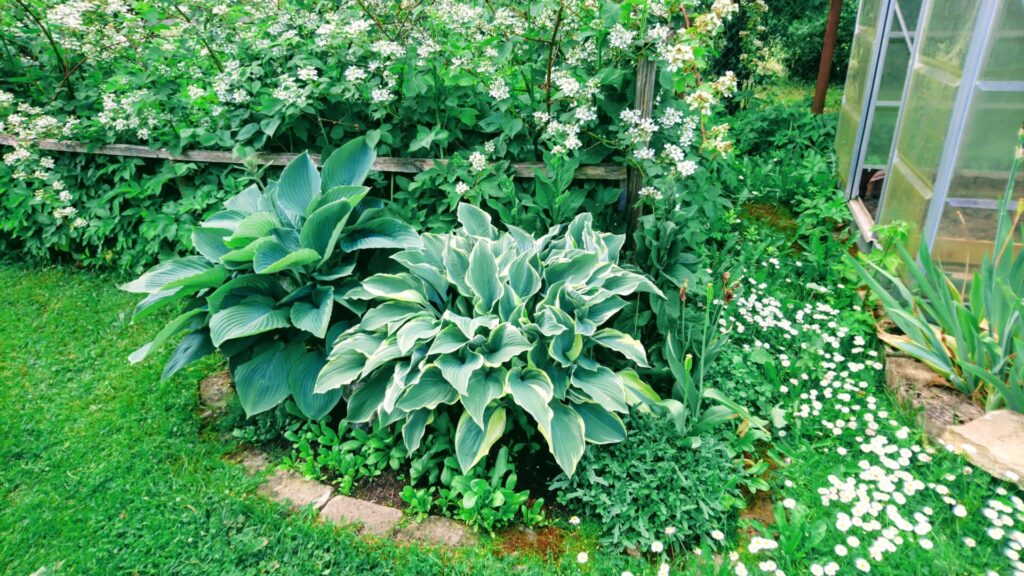
Pildid ei anna kahjuks edasi nende õiget suurust. Tegelikkuses on rohelise lehega Empress Wu sellel pildil juba umbes 80 cm kõrgune.
Unfortunately, the pictures do not convey their true size. In reality, Empress Wu with a green leaf is already about 80 cm tall in this picture.
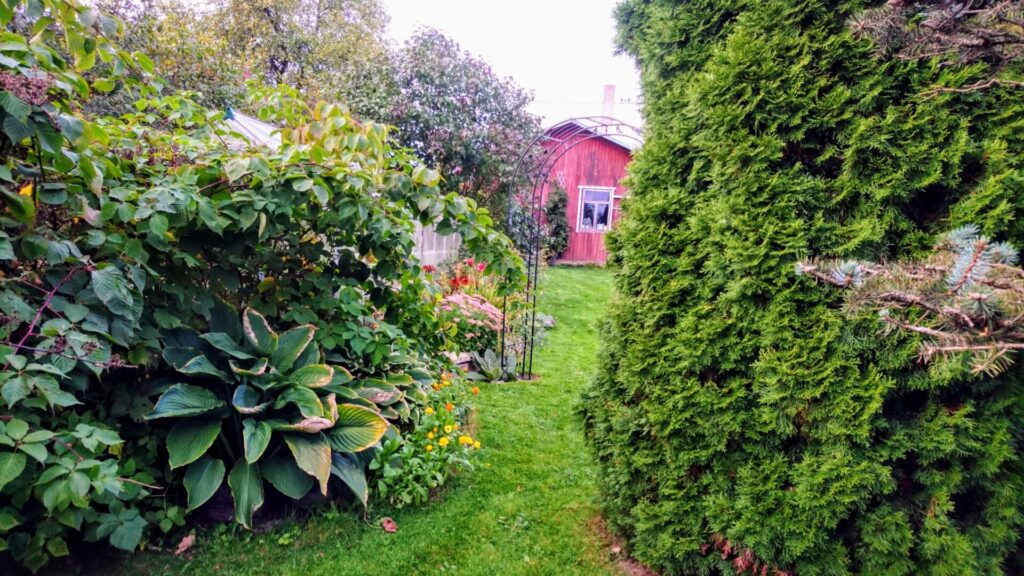
Pidev sissisõda naatidega meie aias muudkui aga jätkub. Hostad on selleks ühed parimad kaaslased, nende puhmikutesse naljalt naat sisse ei roni ja laienedes trügivad nad vaikselt naadi välja. Nii ostsingi 2018. aastal kokku hulga erinevaid hostasid ja istutasin probleemsetesse kohtadesse. Ette rutates võin öelda, et nad on oma ülesandega suurepäraselt toime tulnud. Kui vastane nende ümbert veel päris hävinud pole, siis sõja lõpp tundub igatahes lähedal olevat. Nelja aastaga on nad suutnud juba nii korralikult laieneda, et osa neist vajavad juba ruumikamasse kohta ümberistutamist. 2018 ostetud tegelased:
The constant guerilla war with the ground elders in our garden continues. Hostas are one of the best companions for this, ground elders don’t get into their clumps, and when hostas expand, they quietly push ground elders out. So in 2018 I bought a bunch of different hostas and planted them in problem areas. In a hurry, I can say that they have coped with their task perfectly. If the enemy is not yet completely destroyed around them, the end of the war seems to be near anyway. In four years, they have managed to expand so well that some of them already need to be transplanted to a more spacious place. Characters purchased in 2018:


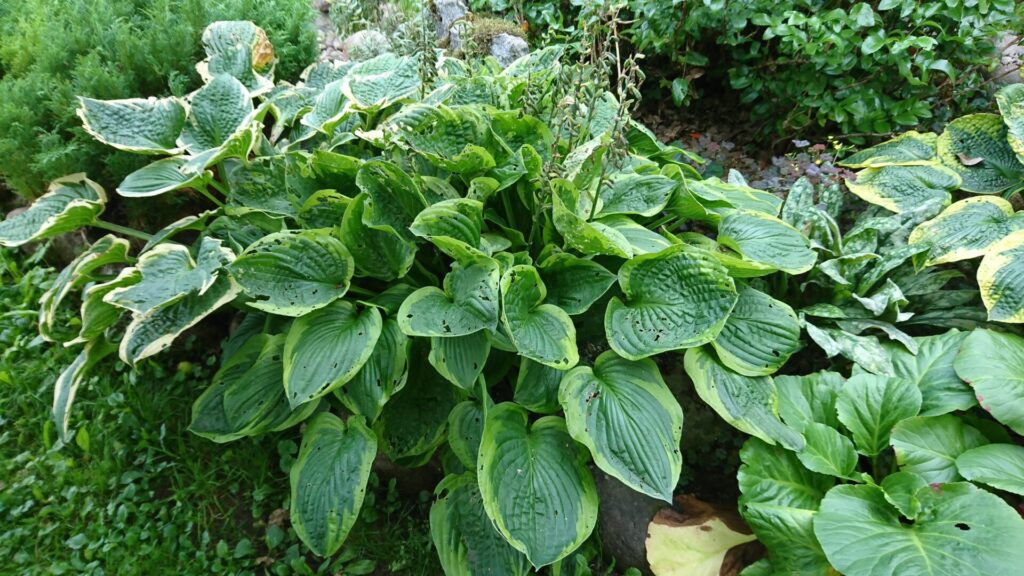
Kui Abiqua Moonbeamile võib õiguse pitsiliseks näritud olla andeks anda, siis hosta Climax peaks kirjanduse andmetel olema teokindel. Noh, meie aia õgardid pole sellest kirjandusest igatahes midagi kuulnud. Selline näeb siis välja augustilõpu seisuga meie hosta Climax:
If Abiqua Moonbeam has the right to be chewed into lace and can be forgiven for it, hosta Climax should be snail-proof according to the literature. Well, the devourers in our garden have never heard of this literature anything. This is what our hosta Climax looks like at the end of August:
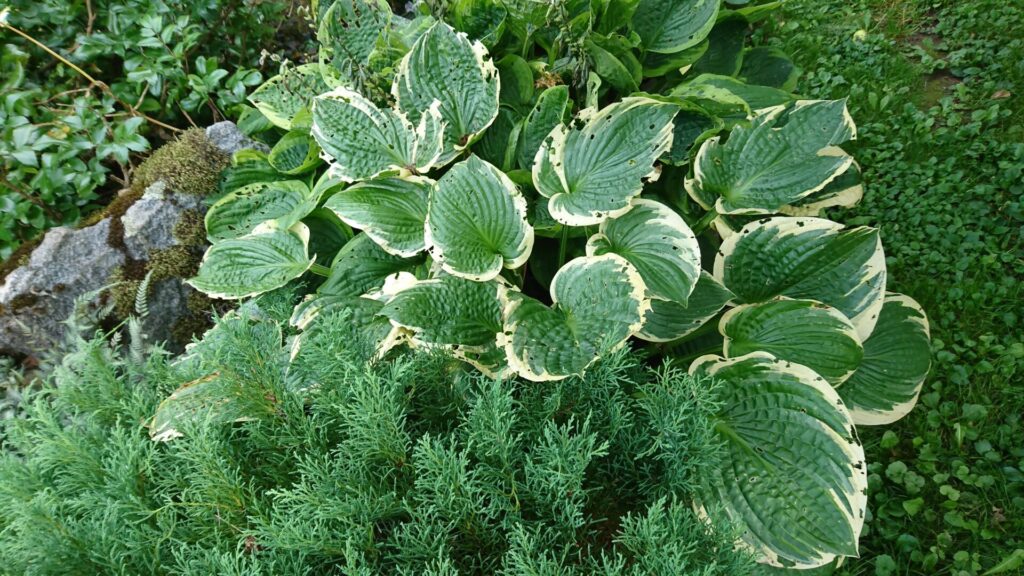
Pean mõtlema, kuidas sinna põõsasse kiire intenetiühendus organiseerida. Las loevad siis, kuidas asjad olema peavad. Või nojah, teine variant on lihtsalt tigudele mürki panna. Peab uurima, kumb variant odavam tuleks.
I have to think about how to organize a fast internet connection in that bush. Let them read how things should be. Or, well, another option is to simply put poison on the snails. You have to find out which option would be cheaper.
Climaxi suureks plussiks võib muidugi lugeda tema kiiret kasvu. Climax on üks neist, kes vajab kiiremas korras ruumikamat kasvukohta. Kõige kiiremakasvulisem oli viimatinimetatutest küll Abiqua Moonbeam, aga tema jääb esialgu samale kasvukohale.
Of course, one of the big pluses of Hosta Climax is its rapid growth. Climax is one of those who urgently needs a more spacious place to grow. Of the latter, Abiqua Moonbeam was the fastest-growing, but it will remain in the same place of growth for the time being.
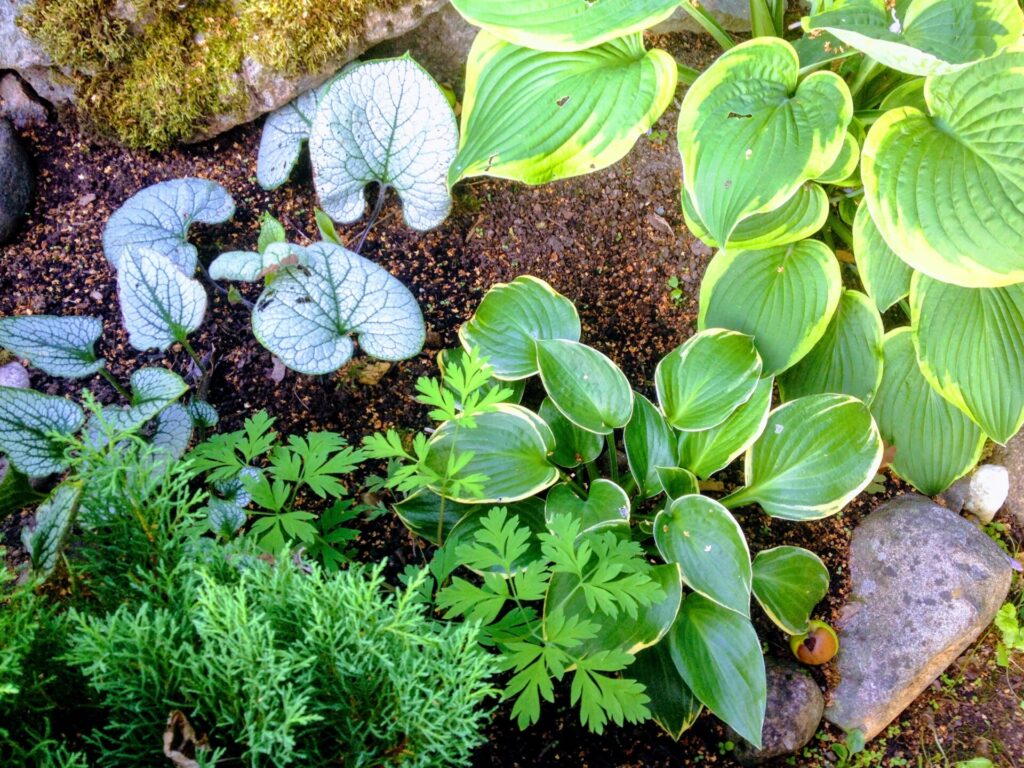
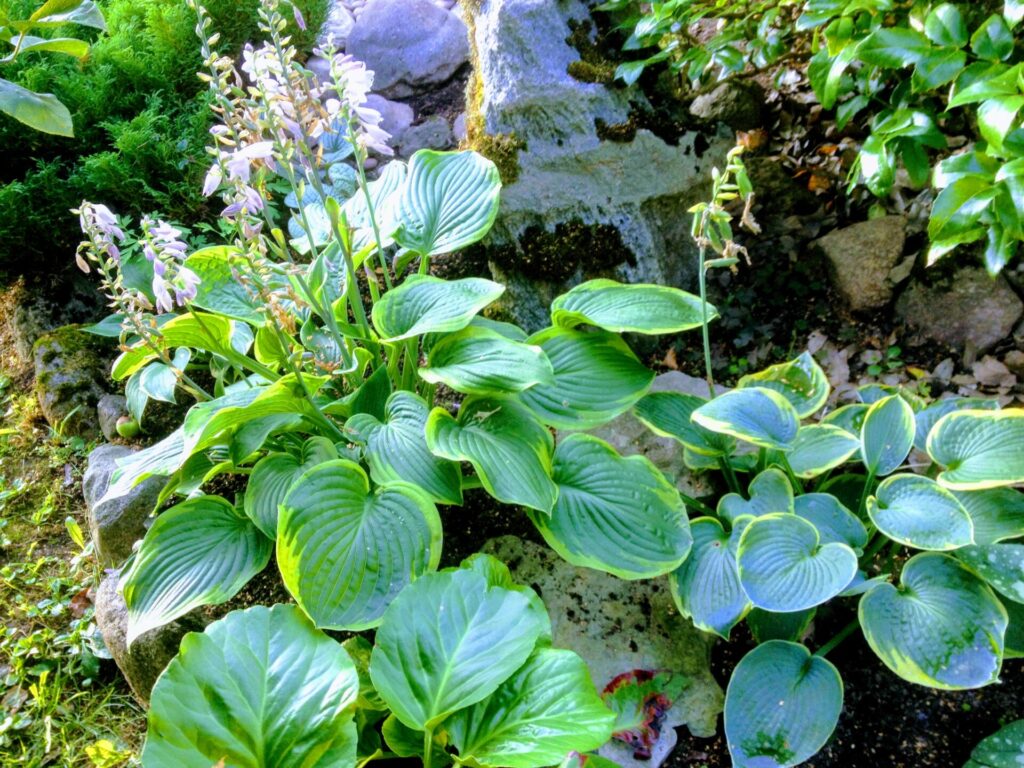
Kõige väiksemat kasvu on meie hostadest Carousel. Ka tema kuulub tigude magustoidu hulka.
The smallest of our hostas is Carousel. He too belongs to the dessert of snails.
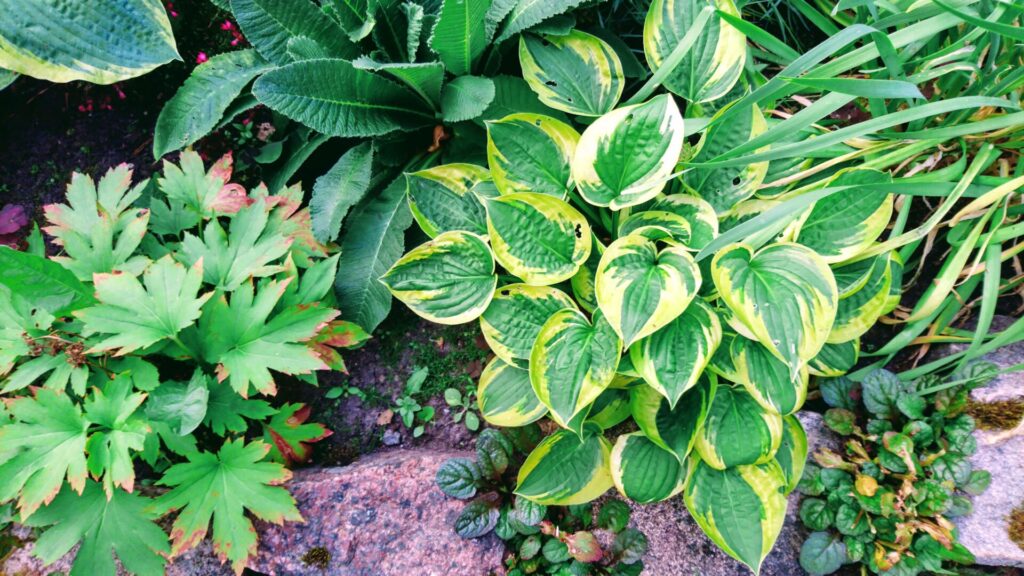
Aastal 2019 komistasin ühel müügiplatsil poolkogemata hosta Orange Marmalade otsa ja armusin esimesest silmapilgust. Tema pärast tuli ette võtta suur kaevamistöö ja aia taha kolida tükk ilusat valgetriibulise lehega päevaliiliat. Kõik ikka sellepärast, et uus lemmik saaks nähtaval kohal pidevalt uhkeldada. Peaks tahtma nagu õigele hostale kohane poolvarjulist kasvukohta, aga meil istub täispäikeses kuival kasvukohal ja tundub väga rahul olevat. Teod veidi maiustavad, kui kallale pääsevad, aga õnneks nad sinna päikese kätte väga ei kipu.
In 2019, I half-accidentally came across hosta Orange Marmalade at a sales site and fell in love at first sight. For him, a big digging job had to be done and a piece of beautiful daylily with white striped leaves had to be moved to the back of the garden. All because the new favorite could constantly show off in a visible place. It should like a semi-shaded place like a proper hosta, but we have it sitting in a dry place in full sun and it seems to be very happy. Snails chew him a little when they get to him, but luckily they don’t go there in the sun very much.
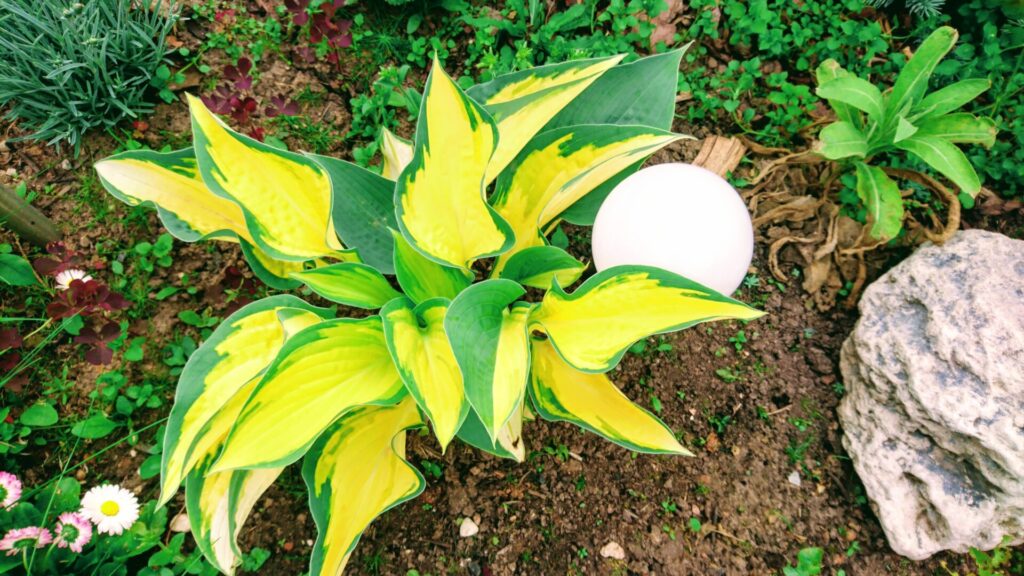
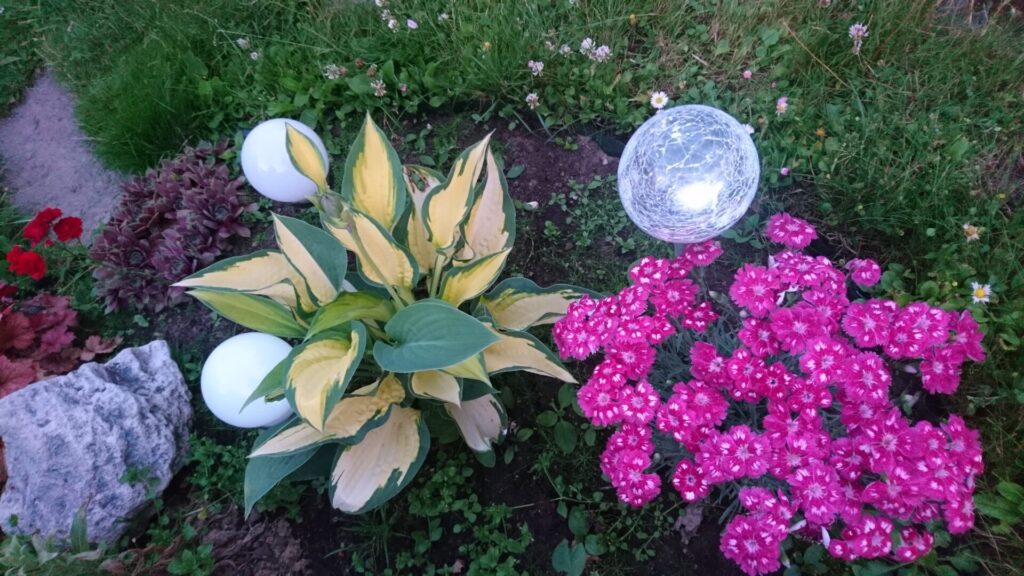
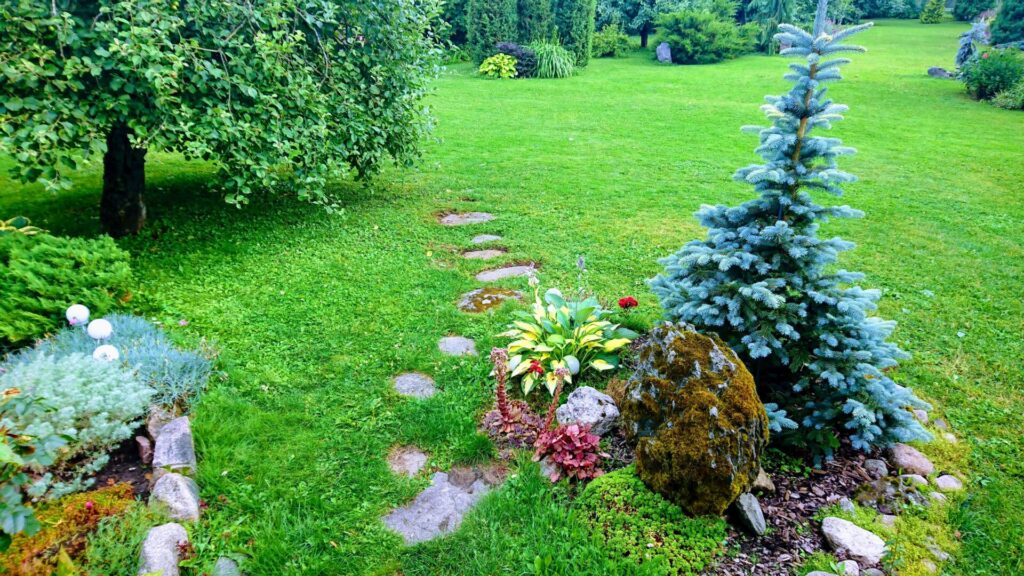
Järgmisel aastal, 2020, istutasin varjuaeda hostad Bullet Proof ja Golden Meadows. Teod neid eriti ei taha, aga kuna nad on istutatud kirsipuu juurte mõjualasse, pole nad veel õiget iseloomu näitama jõudnud hakata.
The following year, 2020, I planted Bullet Proof and Golden Meadows hostas in the shade garden. The snails don’t particularly want them, but since they are planted in the area of influence of the cherry tree’s roots, they have not yet started to show their proper character.

Samal aastal saabusid varjuaeda kolm pisikest hostat Blue Mouse Ears ja hosta Blue Vision. Tundub, et nad puujuurte mõjualas just väga rahul pole. Vähemalt suurt laienemist ei paista kusagilt.
In the same year, three tiny hostas Blue Mouse Ears and hosta Blue Vision arrived in the shady garden. It seems that they are not very happy in the area of influence of the tree roots. At least the big expansion is nowhere to be seen.
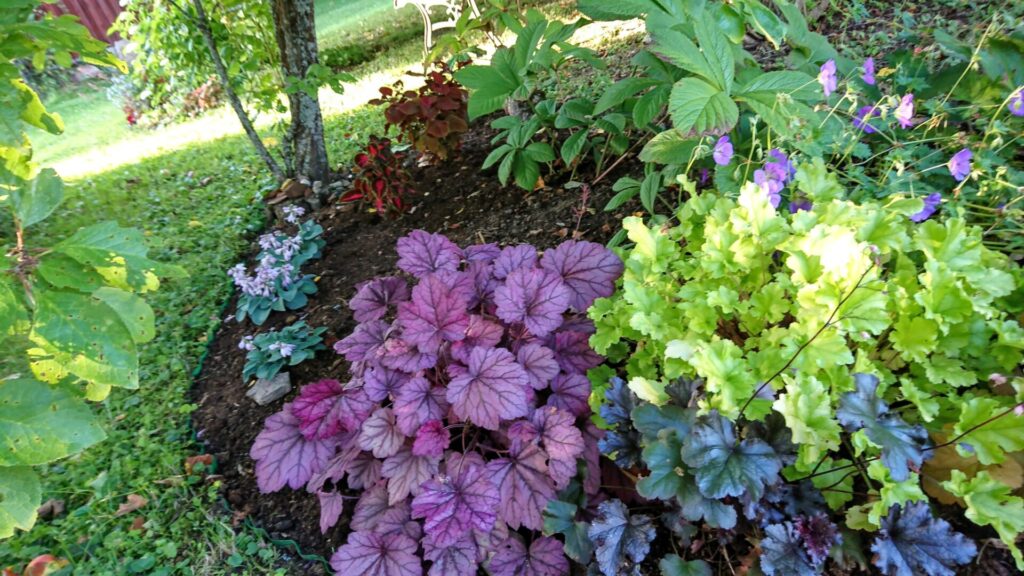
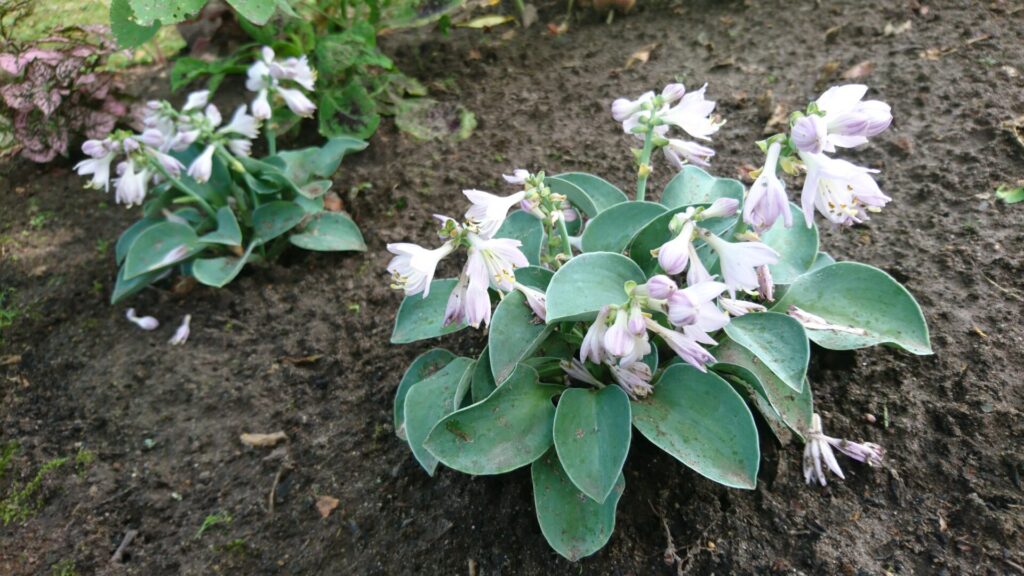
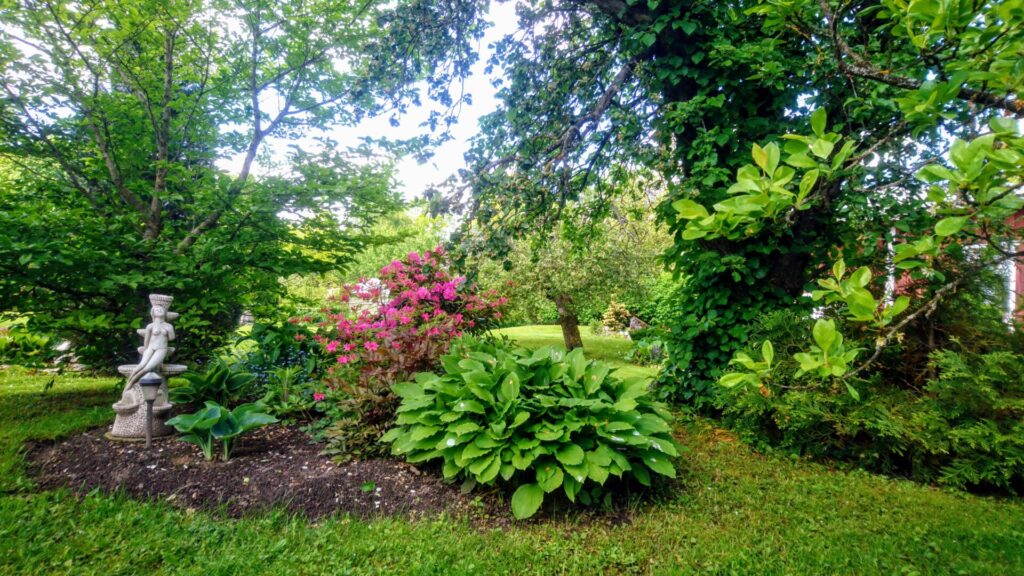
2020 on istutatud ka hosta Blue Ivory, kelle kiiret kasvamist ma pikisilmi ootan, et saada kiviktaimlasse suvist erksat värvilaiku. Tigudele ta õnneks eriti ei meeldi.
Hosta Blue Ivory has also been planted in 2020, whose rapid growth I’m looking forward to in order to get a bright spot of summer color in the rock garden. Fortunately, snails don’t like him very much.
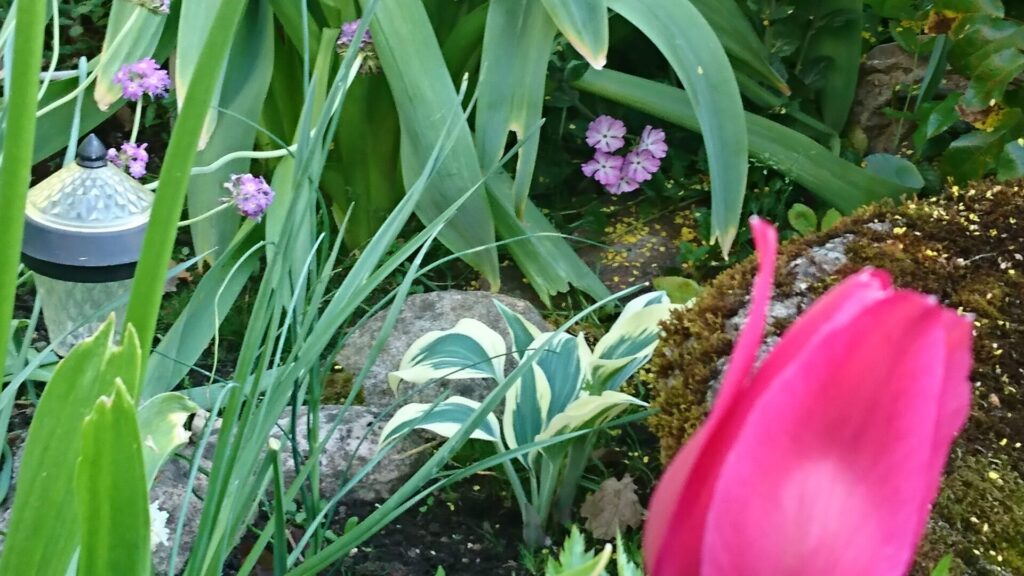
2021 ostetud hosta Fire and Ice ei näita veel isegi mitte sordiomast värvi, kuigi on istutatud suurte puude varju.
The hosta Fire and Ice purchased in 2021 does not even show varietal color yet, despite being planted in the shade of large trees.
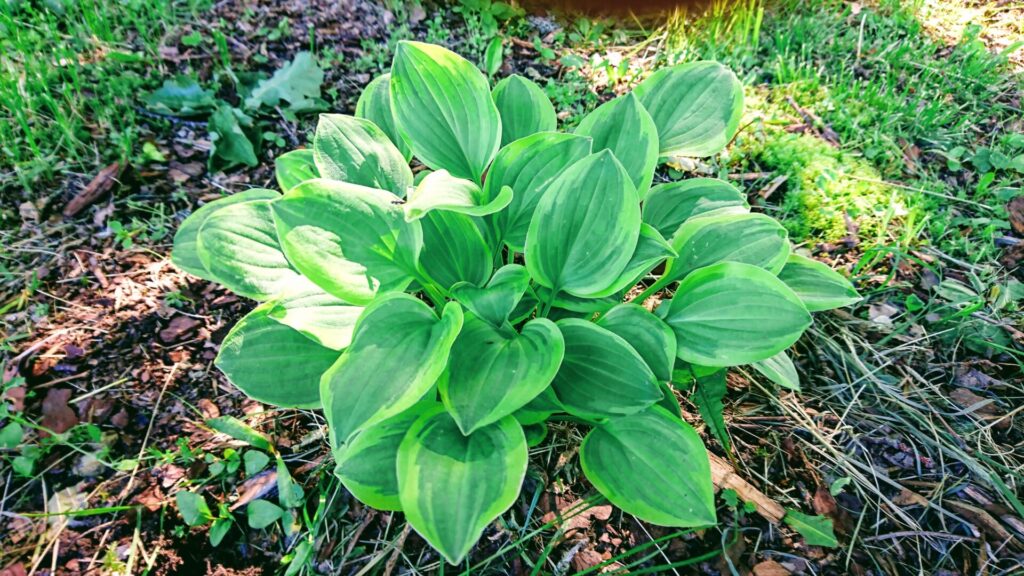
Samal aastal tellisin veel neli hostat: Wu-La-La, Blue Angel, Dream Queen ja Victory. Peale Dream Queeni redutavad ülejäänud kolm siiani ajutistes kasvukohtades, sest tulikuum põuasuvi tuli peale ja öösel lambivalgel on väga tülikas maad kaevata. Aga esialgu võivad nad väga hästi ka sealsamas jõudu koguda.
That same year I ordered four more hostas: Wu-La-La, Blue Angel, Dream Queen and Victory. Apart from Dream Queen, the other three are still growing in temporary places, because the scorching hot dry summer came and it is very troublesome to dig the ground at night by lamplight. But for the time being, they can very well gather strength there as well.

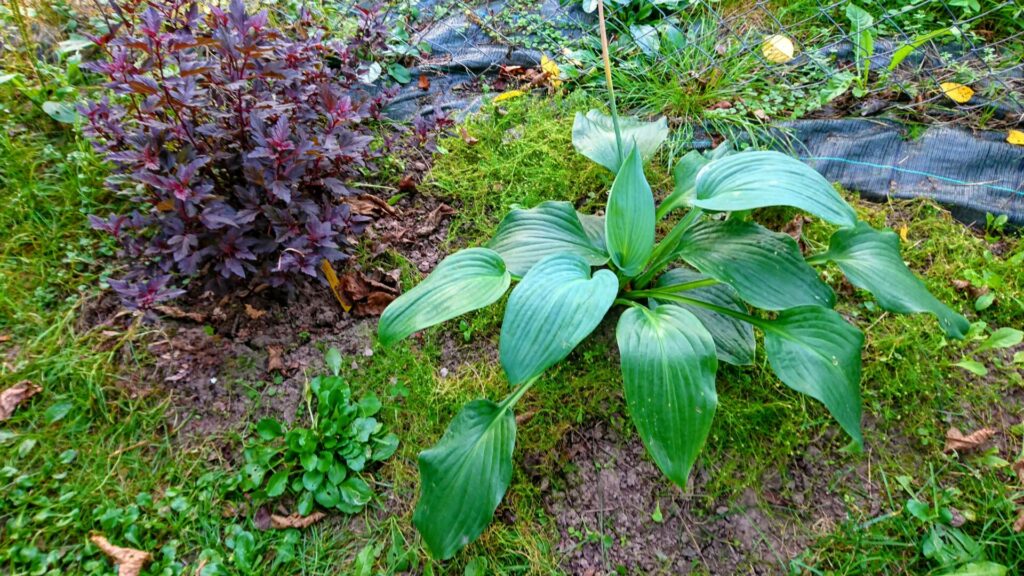
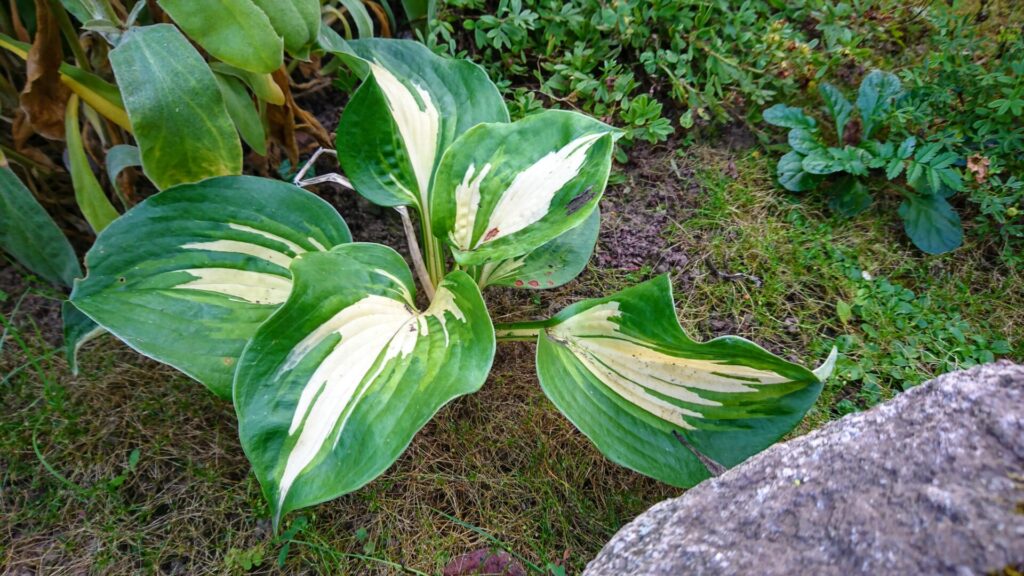
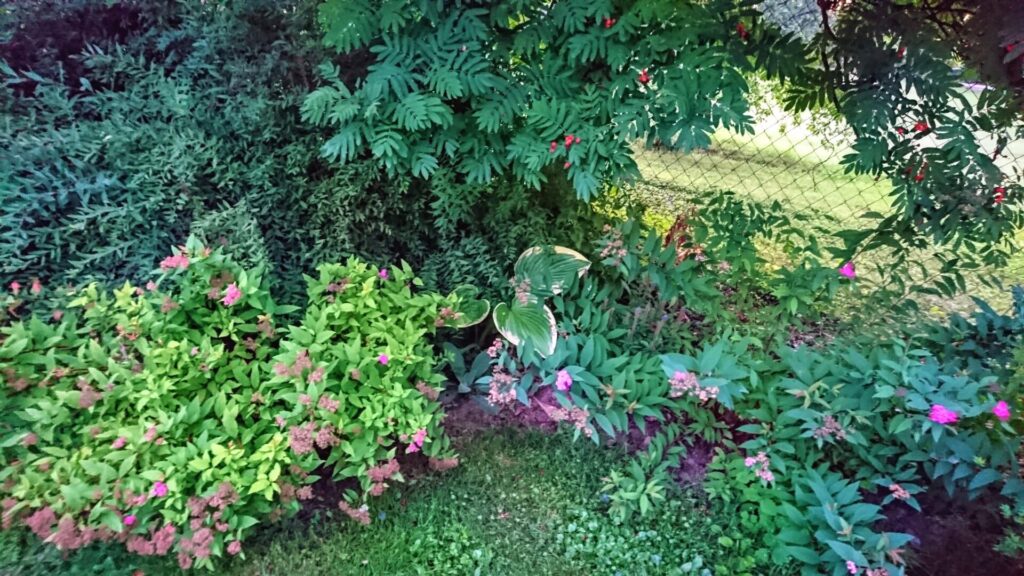
2021 lisandus ka hosta Colored Hulk, kellele kaasa pandud toidu tundub olevat kadakas endale krahmanud. Peale istutamist tundus ta igaljuhul suurem olevat kui käesoleval suvel. Kindel on aga see, et ta on mu kõige ilusamate õitega hosta.
In 2021, the hosta Colored Hulk was also added, and the food included to him seems to have been eaten by the juniper. After planting, it seemed to be bigger than this summer anyway. What is certain, however, is that it has the most beautiful flowers of all my hostas.
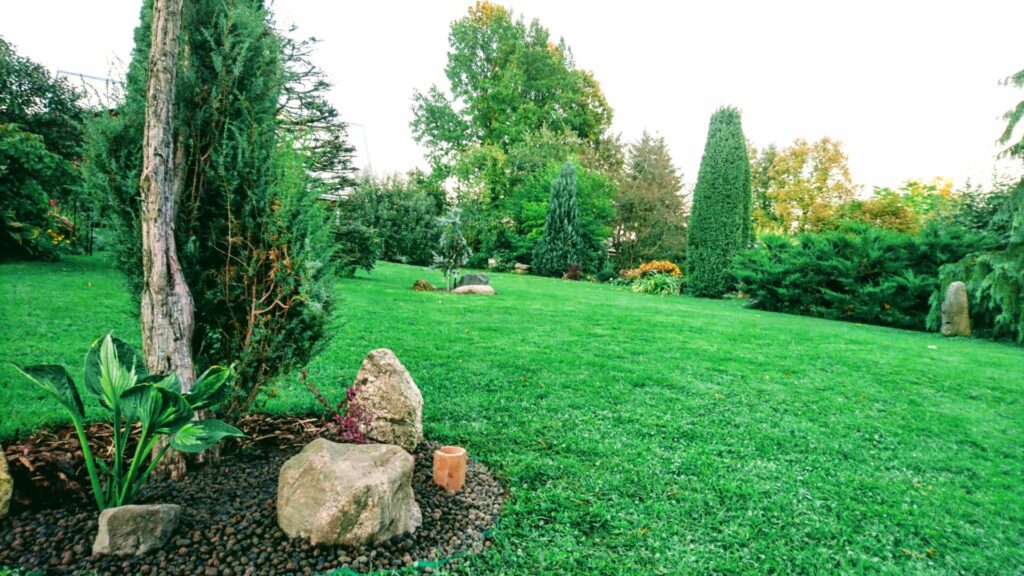
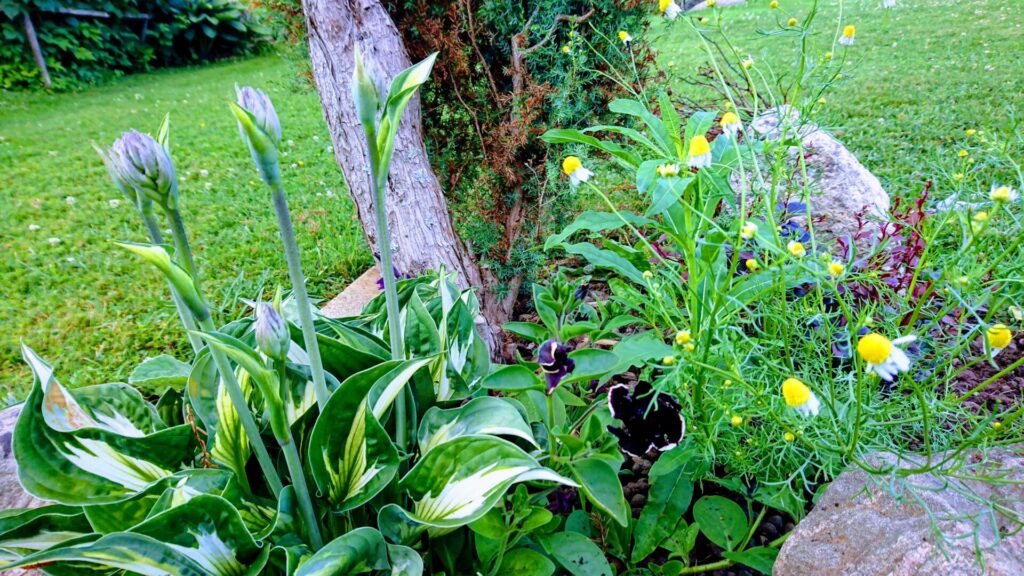
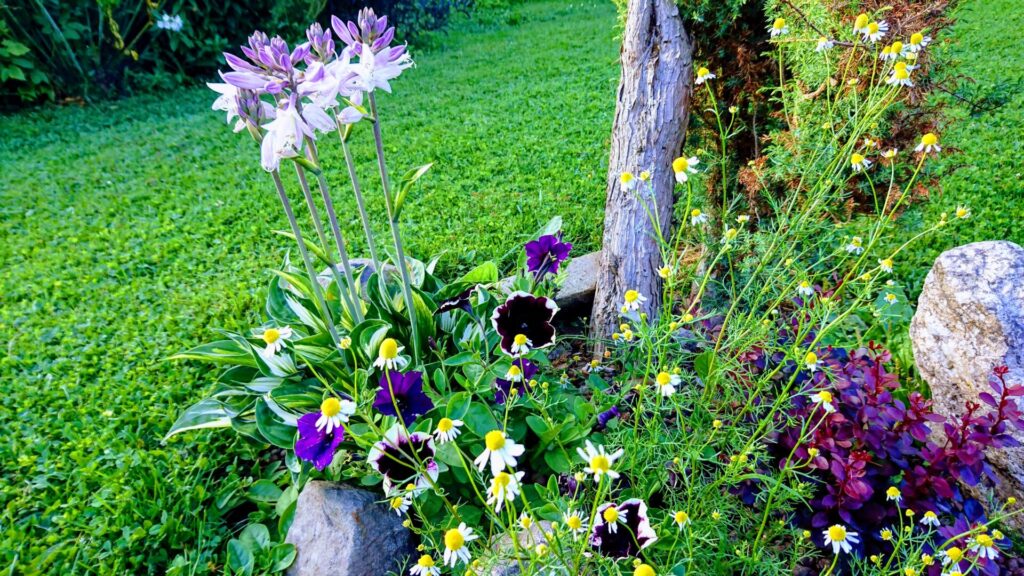
Kirjeldamata on veel üks aastaid tagasi rohevahetuse käigus saadud kaunis hosta, kelle nime ma kuidagi tuvastada ei suuda, sest sarnaseid sorte on väga palju. Kasvab piisava niiskuse olemasolul hästi nii päikeses kui varjus, olen teda mitmesse kohta laiali istutanud. Varjus on rohelisem, päikese käes sinisem, teod söövad teda ainult suure näljaga. Tõenäoliselt on tegu hostaga Karin, aga kindel pole.
Not described is another beautiful hosta obtained during the green exchange many years ago, whose name I can’t identify because there are so many similar varieties. Grows well in both sun and shade if there is enough moisture, I have planted it in several places. It is greener in the shade, bluer in the sun, snails eat it only with great hunger. It’s probably hosta Karin, but I’m not sure.
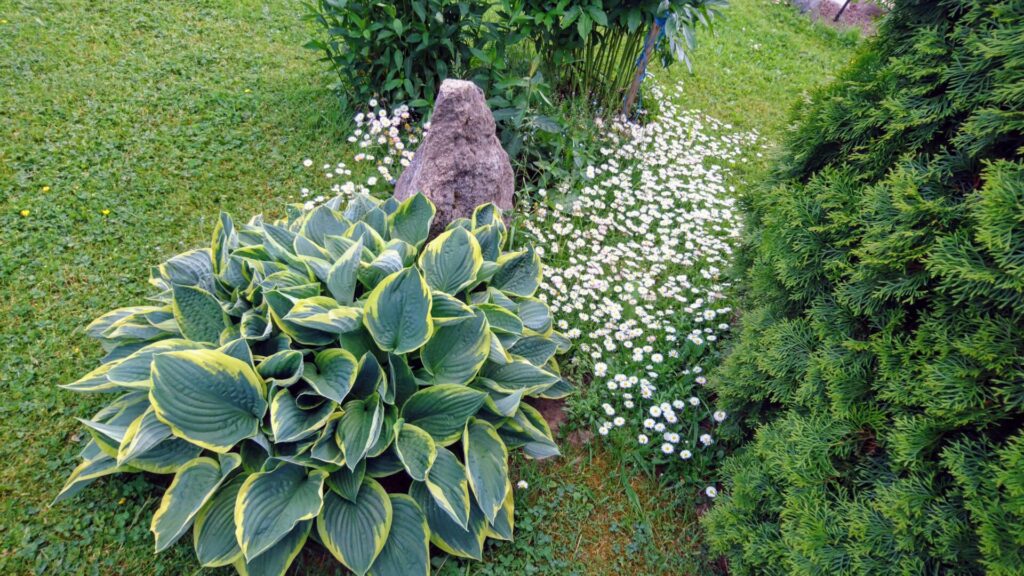
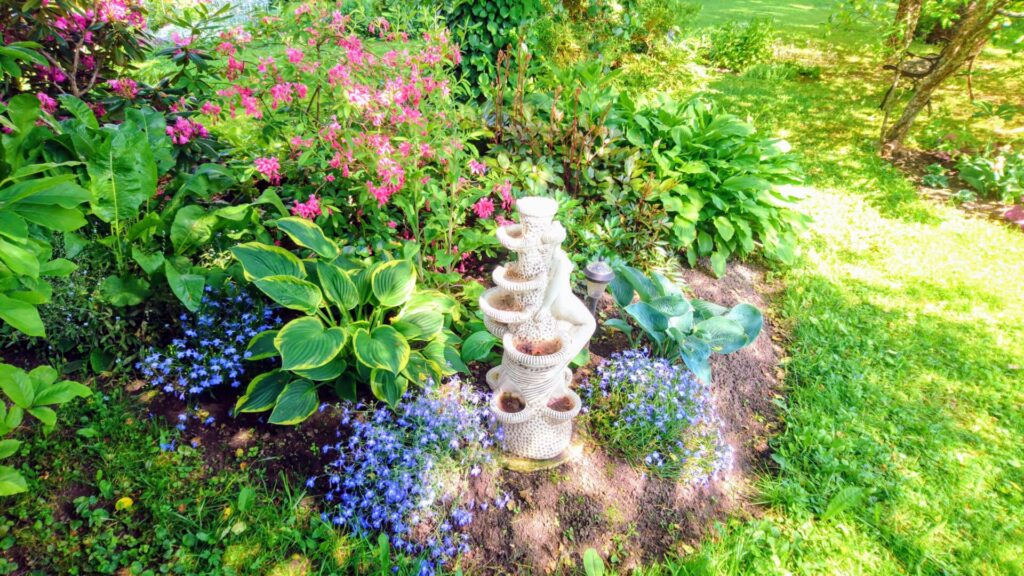
Tegelikult on meil veel teinegi nimetu hosta, kelle sain samuti aastaid tagasi rohevahetuse käigus. Oli tema kääbik, laienes kääbikuna kenasti aastaid nii algses kodus kui ka meie juures. Ja siis mõned aastad tagasi sai ühel ja samal aastal mõlemas majapidamises korraga kääbikust järsku tunduvalt suurem hosta. Igatahes mitte sugugi enam kääbik. Teokahjustusi tuleb vahel ette.
In fact, we have another unnamed hosta that I also got years ago in a green swap. Was his dwarf, expanded nicely as a dwarf for many years both in the original home and with us. And then a few years ago, in one and the same year, in both households at the same time, the dwarf suddenly became a much larger hosta. Anyway, not a midget anymore. Snail damage sometimes occurs.
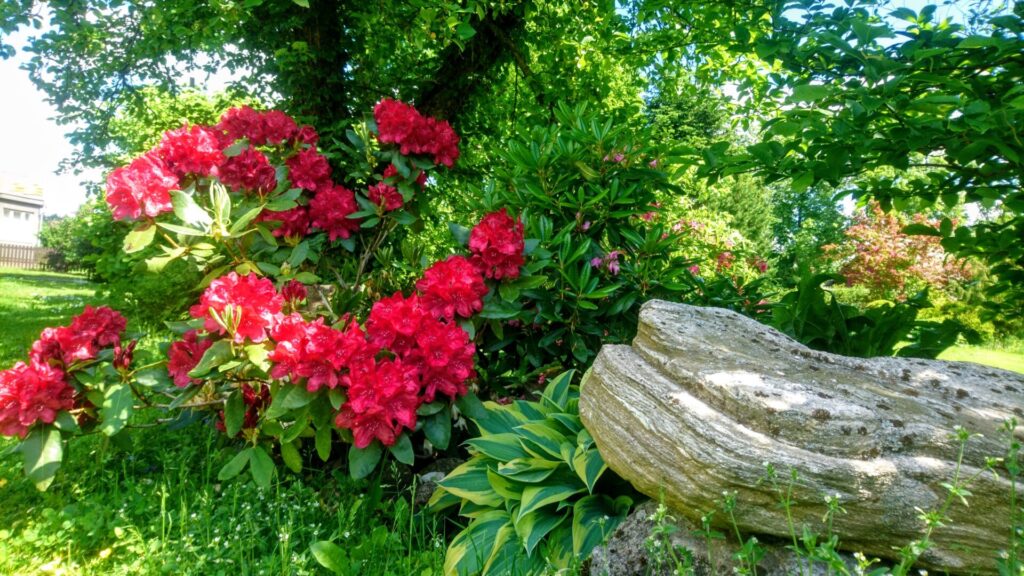
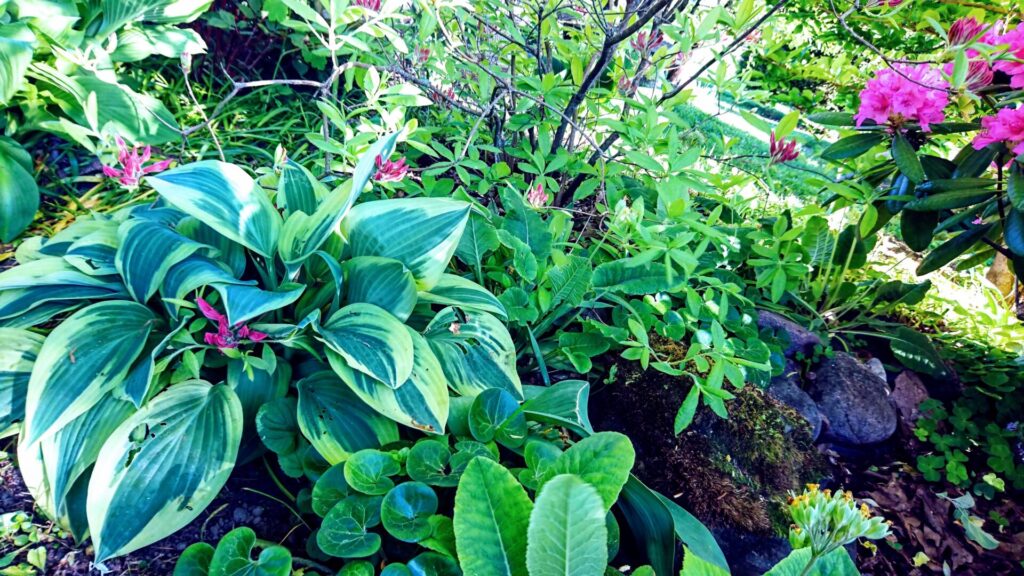
Viimaseks jätsin oma suure lemmiku, suure sõna otseses mõttes. See on 2019. aasta hilissügisel saadud hosta Samurai. Sai tema päästetud ühest ehituse alla minevast peenrast. Hoidsin hinge kinni, kas elab üldse niimoodi vastu talve üles kaevatuna talve üle, aga suurepäraselt elas. Istub kenasti päikese käes, kuigi vähese niiskuse korral kipub veidi kõrbema. Tigudele ta meeldib, mulle ka.
Lastly I left my big favorite, big in the literal sense of the word. This is a late fall 2019 acquired hosta Samurai. He was saved from one of the beds going under the construction site. I held my breath to see if it would even survive the winter like this, but it did perfectly. Sits nicely in the sun, although it tends to burn a little in low humidity. The snails like him, and so do I.
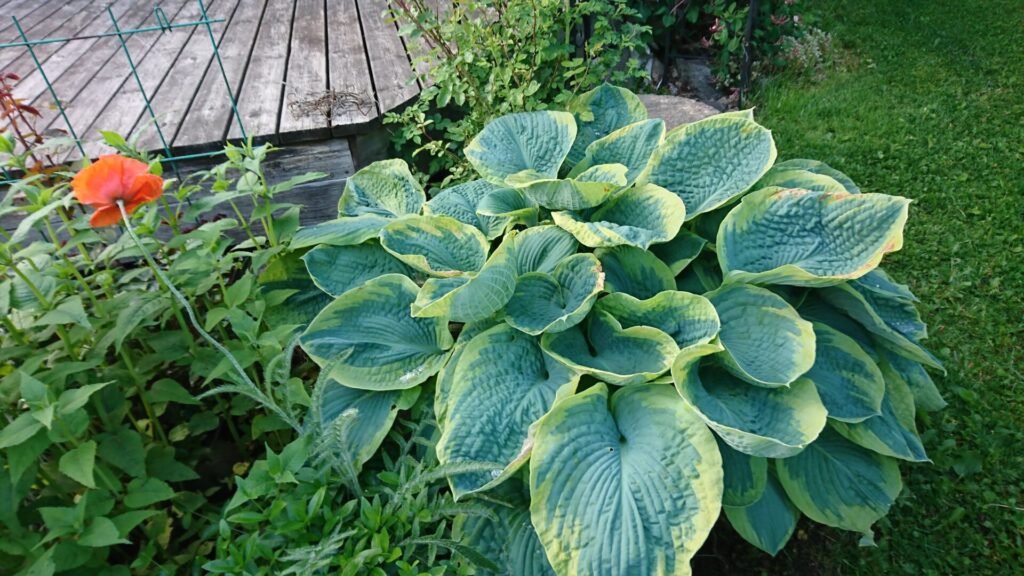
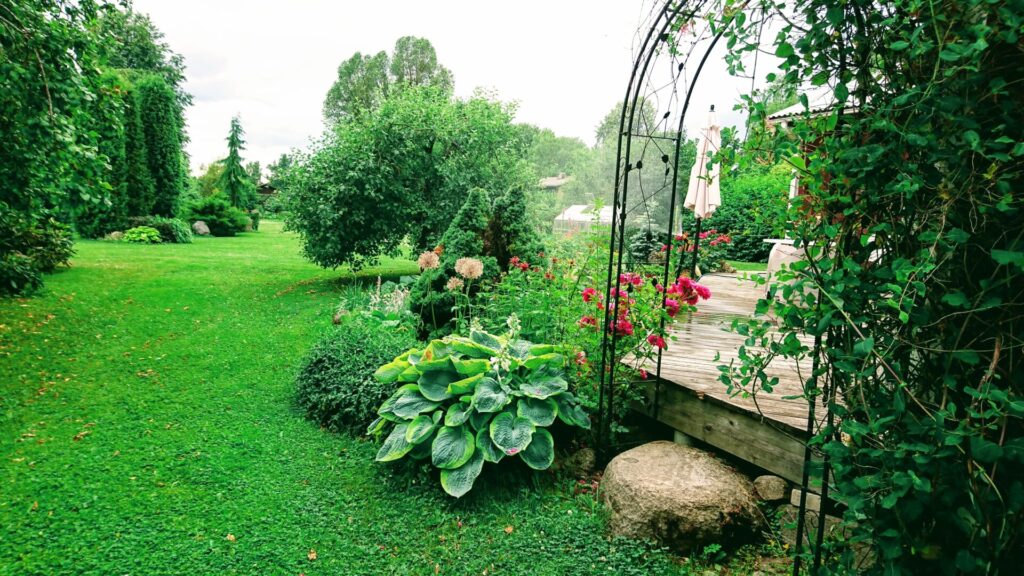
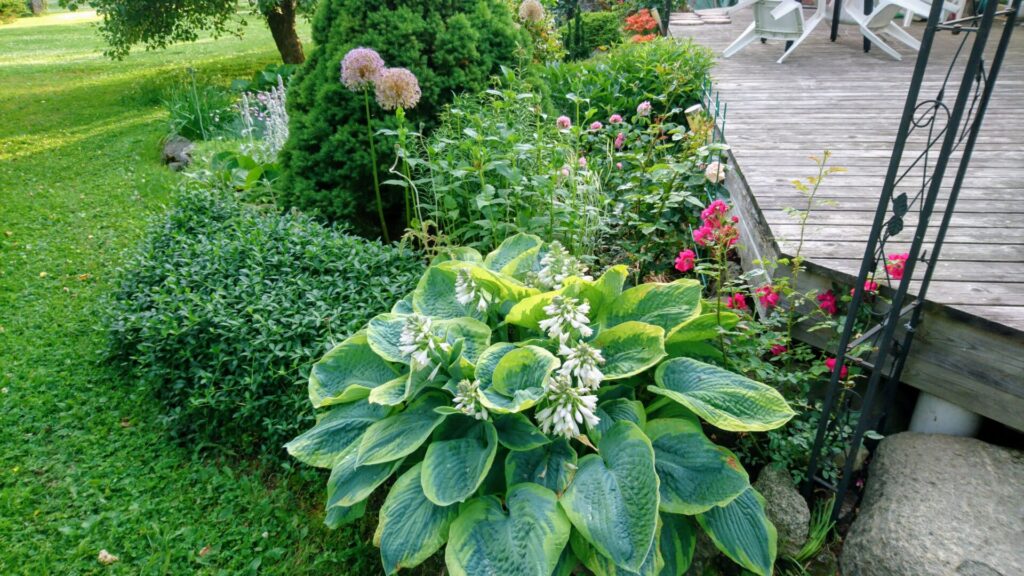
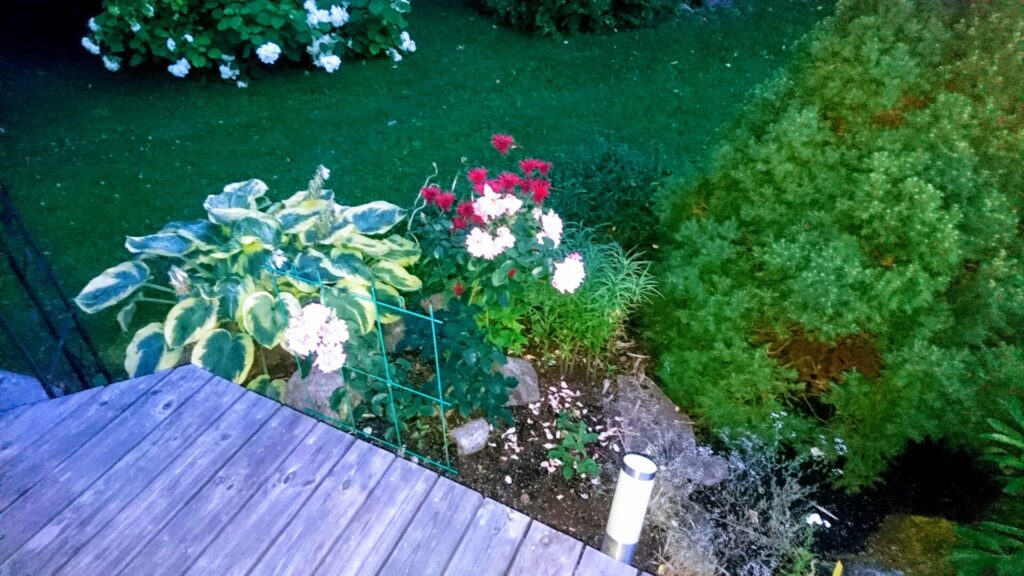
Kõik meie hostad peavad enamasti hakkama saama ilma kastmata-väetamata. Põhitähelepanu saavad nad istutamisest kuni juurdumiseni. Edaspidi saavad üle paari aasta koos teistega aia kevadist üldväetist. Kastetud saab neid ainult suure põuaga. Sügisel lehti maha ei lõika, keeran külmavõetud lehed taime peale kokku ja kevadel saadan need koos sinna kogunenud tigudega parematele jahimaadele. Ja ongi kogu hooldus. Suhteliselt hooldusvabad väga ilusad ja tänuväärsed taimed.
All our hostas mostly have to do without watering or fertilizing. They receive the main attention from planting to rooting. From now on, over a couple of years, together with others, they will receive general spring fertilizer from the garden. We water them only in severe drought. I don’t cut the leaves in the fall, I fold the frozen leaves over the plant and in the spring I send them to better hunting grounds together with the snails gathered there. And that’s all the maintenance. Relatively maintenance-free, very beautiful and rewarding plants.
